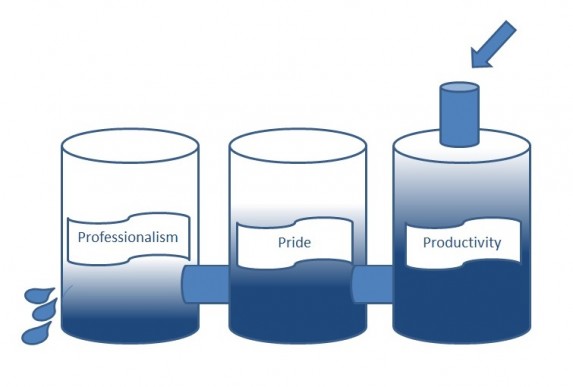
As organizations prepare and then pursue new goals, successes and standards it is important that a core understanding of the ‘why we do what we do’ in addition to the ‘what we are trying to do’. In many cases, the emphasis upon the specific task(s) that fuel the collective effort overshadows what could be a more valuable and consistently high-impact piece of information among an organization’s entire workforce.
As individuals, work groups, divisions and even entire companies strive for a more professional stature, and as they simultaneously incorporate internal programs and promotional sequences to drive a greater energy among its workforce to a desired future state, it is often done with a call for greater productivity with an emphasis upon quantity rather than quality.
In seeking ‘more’–be it more widgets, more service calls, more completed projects, more completed staff training–too frequently a definition of the quality of those additional levels of work and an equally essential definition that supports the ability to assess the quality in context of added effort is usually not established.
When an organization seeks to advance its productive capacity, it is imperative that leaders and their teams all spend enough time to understand how productivity alone will not be the solution to achieving the announced goals. This dialog must solicit input from as many work group members as possible to gain a wide set of perspectives of what “success” means, of what “more” means, and yes–even what “quality” means.
If a company produces widgets with a failure rate of 90%, most would suggest that the time is right to set higher goals. But producing 100 widgets a day and assuming 20 will be unavailable for sale isn’t going to be resolved if the team finds a way to produce 200 a day and find forty that are non-usable.
Therefore, while productivity is indeed the core of any enterprise, we must all understand what exactly we are being called upon to ‘produce’ and then determine in what manner we can BOTH increase that productivity AND then also increase the quality of that work.
When that objective has been fully accomplished, the team then rightly addresses the second task at-hand, and that is making certain that each team member has been provided all of the appropriate resources in training and equipment to perform at the prescribed new standard. If any employee(s) have not been provided these resources, the leader must take all necessary steps to make these investments as quickly as possible so that the employee and the team can and will progress concurrently.
As this new effort gains traction, which includes the leader’s active role and availability to the entire team, the collective and individual pride that develops becomes quite visible and tangible to one another–and to those they serve. Leaders then have an entirely new array of opportunities in which success is consistently experienced by individuals, small and larger work groups and the organization as a whole and in which those advancements bring moments in which the leader can then also provide professional development assignments to these same team members and further grow the leadership skills of these employees as well. It is important to understand that over time, pride can ebb out–even when productivity may still be quite high. Therefore, it is essential that leaders actively seek opportunities to stem the earliest signs by reaffirming the shared understanding of both the method, form and purpose of the production the organization is dedicated to all of the members.
Leaders will find that quality productivity will actually accelerate the quantity of his or her organization’s productivity at a rate greater than any other form of internal or external goal that is established.
Image Source: California Commission on Peace Officer Standards and Training, Supervisory Leadership Institute (variant).